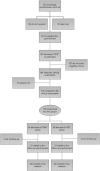Ten weeks of physical-cognitive-mindfulness training reduces fear-avoidance beliefs about work-related activity: Randomized controlled trial
- PMID: 27559939
- PMCID: PMC5400305
- DOI: 10.1097/MD.0000000000003945
Ten weeks of physical-cognitive-mindfulness training reduces fear-avoidance beliefs about work-related activity: Randomized controlled trial
Abstract
People with chronic musculoskeletal pain often experience pain-related fear of movement and avoidance behavior. The Fear-Avoidance model proposes a possible mechanism at least partly explaining the development and maintenance of chronic pain. People who interpret pain during movement as being potentially harmful to the organism may initiate a vicious behavioral cycle by generating pain-related fear of movement accompanied by avoidance behavior and hyper-vigilance.This study investigates whether an individually adapted multifactorial approach comprised of biopsychosocial elements, with a focus on physical exercise, mindfulness, and education on pain and behavior, can decrease work-related fear-avoidance beliefs.As part of a large scale 10-week worksite randomized controlled intervention trial focusing on company initiatives to combat work-related musculoskeletal pain and stress, we evaluated fear-avoidance behavior in 112 female laboratory technicians with chronic neck, shoulder, upper back, lower back, elbow, and hand/wrist pain using the Fear-Avoidance Beliefs Questionnaire at baseline, before group allocation, and again at the post intervention follow-up 10 weeks later.A significant group by time interaction was observed (P < 0.05) for work-related fear-avoidance beliefs. The between-group difference at follow-up was -2.2 (-4.0 to -0.5), corresponding to a small to medium effect size (Cohen's d = 0.30).Our study shows that work-related, but not leisure time activity-related, fear-avoidance beliefs, as assessed by the Fear-avoidance Beliefs Questionnaire, can be significantly reduced by 10 weeks of physical-cognitive-mindfulness training in female laboratory technicians with chronic pain.
Conflict of interest statement
The authors have no conflicts of interest to disclose.
Figures
References
-
- Leischik R, Dworrak B, Strauss M, et al. Plasticity of health. GJOM 2016; 1:1–17.
-
- Soler-Vila H, García-Esquinas E, León-Muñoz LM, et al. Contribution of health behaviours and clinical factors to socioeconomic differences in frailty among older adults. J Epidemiol Community Health 2015; jech – 2015–206406. - PubMed
-
- Punnett L, Wegman DH. Work-related musculoskeletal disorders: the epidemiologic evidence and the debate. J Electromyogr Kinesiol Off J Int Soc Electrophysiol Kinesiol 2004; 14:13–23. - PubMed
Publication types
MeSH terms
LinkOut - more resources
Full Text Sources
Other Literature Sources
Medical


